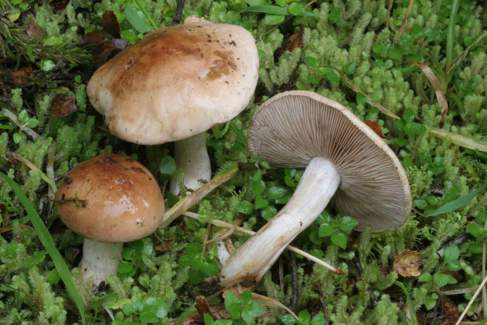 Hebeloma mediorufum (Photo: M.L. Beker)
Hebeloma mediorufum (Photo: M.L. Beker)Taxonomy
Full name: Hebeloma mediorufum Soop, Bulletin trimestriel de la Société Mycologique de France 117 (2): 130 (2001)Genus: Hebeloma
Section: 'Mediorufa'
Types: NEW ZEALAND: South Island, Walker Creek Rest Area, Te Anau (approx. 45.1006°S, 167.9684°E, alt. approx. 270 m a.s.l.) under Nothofagus sp., 17 Apr. 1999, K. Soop (Holotype. herbarium acc. no. PDD 70514, HJB1000547).
- arrow_drop_downarrow_drop_upEtymology
- arrow_drop_downarrow_drop_upOriginal diagnosisPileo 3.5 - 6 cm, globoso, deinde convexo, ex viscoso glutinoso, haud hygrophano, pallide griseobrunneo usque rufo, glabro; margine pallidior, albo-canescente, junior subpruinoso, senior substriato. Lamellis primo albo-griseis, confertis, acie pallidior. Stipite ex aequali subattenuato, subcurto, albo-canescente, tenuiter albo-micaceo, apice pruinoso. Velo valde sparso, probabiliter albo; cortina nulla. Carne alba, odore saporeque nullis. Sporis amygdaloideis, 9.3 - 11.5 x 6-6.8 μm, verrucosis. Reactio ope NaOH nulla. In silvis cum Nothofagete, subfrequente.
- arrow_drop_downarrow_drop_upEnglish translationPileus 3.5-6 cm, globose, then convex, viscid to glutinous, non hygrophanous, pale greyish-brown to red, glabrous; margin paler, white-hoary, subpruinose when young, substriate in age. Lamellae at first whitish-grey, crowded, with paler edge. Stipe equal to slightly tapered, somewhat short, white-hoary, slightly glittering with white mica-like particles, pruinose at the apex. Veil strongly scattered, most likely white; cortina none. Context white, smell and taste none. Spores amygdaloid, 9.3-11.5 x 6-6.8 μm, roughened. No reaction with NaOH. Rather frequent in woods with Nothofagus.
References
Description
- arrow_drop_downarrow_drop_upThresholds
Description of Hebeloma mediorufum based on 12 collections
- arrow_drop_downarrow_drop_upMacroscopic descriptionPileus: (23) 37–69 (70) mm diameter; shape often convex, occasionally umbonate or broadly umbonate, rarely applanate or strongly umbonate; characters Not recorded; margin characters often involute, occasionally sulcate or scalloped, rarely eroded or smooth; viscosity tacky when moist; colour variation usually two color, rarely unicolour; colour at centre occasionally fawn, yellowish brown, cinnamon or brick.
Lamellae: attachment usually emarginate, occasionally adnexed; maximum depth up to 5 mm; number of complete lamellae 76–100; presence of tears usually absent, occasionally visible with naked eye; white fimbriate edge present.
Cortina presence: no.
Stipe: (38) 46–72 (73) x 7–13 (14) {median} x (7) 8–14 (15) {basal} mm; stipe Q 4.1–9.1; base shape often cylindrical or clavate, occasionally tapering; floccosity often floccose, occasionally pruinose at apex, rarely fibrillose; rooting no; thick rhizoids at base absent;
Context: Texture firm; stipe interior hollow, often superior wick; stipe flesh discolouring no; slenderness measure 4.8–15.9; smell usually odourless, occasionally fruit; taste often none, occasionally bitter or weakly bitter where recorded.
Spore deposit colour: Not recorded.
Exsiccata characters: hard.
- arrow_drop_downarrow_drop_upMicroscopic descriptionSpores: shape amygdaloid, usually limoniform; colour in microscope often brown, occasionally yellow brown; guttules often yes, occasionally no. papilla usually very strongly, occasionally yes; Spore Code: O3 O4; P3; D3 D4.
Basidia: 24–37 (39) x 6–9 μm; ave. Q 3.5–4.3; spore arrangement 4 spored;
Cheilocystidia: main shape usually clavate-stipitate, often capitate-stipitate, occasionally capitate, rarely balloon-shaped, clavate, cylindrical or spathulate-stipitate; special features observed often septa or clamped septa, occasionally irregular, apical thickening, branching, conglutinate, many collapsed in exsiccata or bifurcate, rarely rostrate; cheilocystidia ratios: A/M = 1.92–2.75; A/B = 2.14–2.68; B/M = 0.87–1.26.
Pleurocystidia: none seen.
Ixocutis: epicutis thickness (measured from exsiccata) up to 150 μm; ixocutis hyphae width up to 8 μm; ixocutis hyphae encrustation variable; shape of trama elements beneath subcutis cylindrical, often ellipsoid or thickly sausage-shaped up to 17 μm wide.
Caulocystidia: Similar to cheilocystidia but larger, up to 100 μm.
- arrow_drop_downarrow_drop_upSpore measurements
- arrow_drop_downarrow_drop_upCheilocystidia measurements
- arrow_drop_downarrow_drop_upHabitat and distributionHebeloma mediorufum's preferred habitat appears to be deciduous woodland, mixed woodland or woodland ditch with soil or boggy, mossy soil. Where only one possible associate was recorded, that associate has always been Nothofagus (family Nothofagaceae). We have additional records where Fagus and Melaleuca were recorded as possible associates, but in these cases a number of possible associates were mentioned. Overall the most commonly recorded families are Nothofagaceae (80.0%), Myrtaceae (20.0%) and Fagaceae (10.0%) The growth habit of our collections was often scattered, occasionally solitary and rarely caespitose or gregarious.
According to our current collections, the species is found only in Australasia. On the continent, collections has been found in the WWF biomes The World Wildlife Fund (WWF) have divided the world into 867 terrestrial ecoregions. The ecoregion here is estimated by mapping from the GPS coordinates of the collection using data made available by Dinerstein et al (2017). Use this webtool to explore the ecoregions visually or see a full list of current ecoregions on Wikipedia. temperate broadleaf & mixed forests (66.7%) and montane grasslands & shrublands (33.3%), specifically including the ecoregions: New Zealand South Island montane grasslands (33.3%), New Zealand North Island temperate forests (22.2%), Nelson Coast temperate forests (22.2%), Richmond temperate forests (11.1%) and Fiordland temperate forests (11.1%). From collector information, it appears collections have been found only in the 1.4 Forest – Temperate IUCN habitat We map from the collector's description of the habitat to the International Union for Conservation of Nature (IUCN)'s definition using a standardised set of rules. Please see this page for a full list of IUCN habitats.. Within Australasia all our records are from New Zealand (New Zealand).
Geographic distribution
Phenology
- arrow_drop_downarrow_drop_upAdditional cited collections